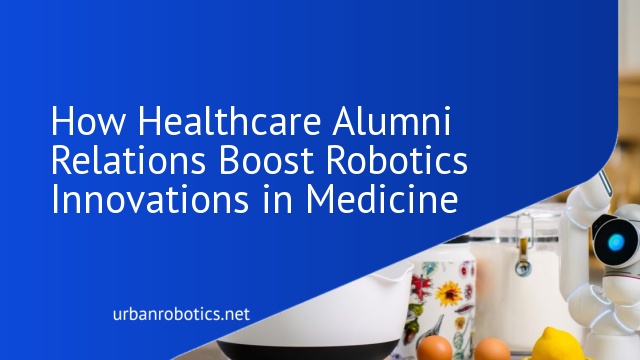Importance of Healthcare Alumni Relations
Healthcare alumni relations play a pivotal role in advancing our field. They enable us to foster innovation, share knowledge, and drive growth, especially in integrating robotics.
Building a Strong Network
A robust alumni network connects professionals across various specialties. Collaboration between experienced practitioners and young graduates leads to knowledge-sharing. For example, seasoned surgeons adopting robotics can mentor new doctors. This cohesion creates fertile ground for advancements in medical technology.
Enhancing Career Opportunities
Alumni relations open doors to numerous career paths. Connections within this network often lead to job placements, internships, and collaborative research. For instance, a graduate skilled in robotic-assisted surgery can find opportunities through alumni referrals. These connections provide valuable career growth and enhance professional development.
Introduction to Robotics in Healthcare
Robotics has transformed the healthcare landscape. Advanced robotics technology is enhancing patient outcomes and streamlining medical processes.
Historical Context
Robotics in healthcare began with simple automated systems in the 1980s. Robotic-assisted surgery emerged as a game-changer in the 1990s, with the da Vinci Surgical System approved by the FDA in 2000. These early advancements set the stage for more complex and capable medical robots, which have since evolved to perform a wide range of tasks from minimally invasive surgeries to patient rehabilitation.
Current Trends
Today, robotics in healthcare includes surgical robots, rehabilitation robots, and robotic prosthetics. Artificial intelligence (AI) integration is a key trend, enabling more precise diagnostics and personalized treatment plans. Telemedicine robots are becoming more common, improving access to healthcare in remote areas. Autonomous mobile robots in hospitals are now used for tasks like delivering medication and disinfecting rooms, enhancing operational efficiency and safety.
Integrating Robotics with Alumni Relations
Alumni relations significantly influence the integration of robotics in healthcare. Collaborations between alumni and institutions drive advancements in medical robotics.
Collaborative Research and Development
Research projects, combining the expertise of alumni and current faculty, often yield groundbreaking results. These partnerships benefit from alumni’s industry experience and access to cutting-edge technology. For instance, alumni may provide insights into robotic-assisted surgeries or contribute to developing new robotic systems. Moreover, joint grants and funding from alumni networks amplify the research capabilities of healthcare institutions.
Alumni-Led Innovation
Alumni frequently spearhead innovative projects in robotics. Their ventures often result in startups or partnerships that push the boundaries of medical technology. For example, an alumnus might develop AI-driven diagnostic robots or create advanced rehabilitation devices. These innovations not only enhance patient care but also position the alma mater as a leader in healthcare robotics. Alumni-driven initiatives ensure continuous progress and real-world applications of emerging technologies.
Case Studies
Exploring real-world applications helps illustrate the impact of alumni on robotics in healthcare. Below, we highlight successful projects and lessons learned from failures.
Successful Alumni-Robotics Projects
Several alumni-driven projects in medical robotics show concrete success. For example, Stanford University alumni collaborated to create the da Vinci Surgical System, revolutionizing minimally invasive surgery. Similarly, MIT alumni contributed to developing AI-driven diagnostic robots, significantly enhancing early disease detection. These projects underscore the value of leveraging alumni expertise in advancing healthcare technology.
Lessons Learned from Failures
Not all projects succeed, and understanding failures is crucial. For instance, a collaboration from University of California alumni on a robotic-assisted therapy device faced significant challenges due to insufficient clinical trials. In another case, Harvard alumni’s attempt to develop a robotic exoskeleton faltered because of high manufacturing costs. These experiences highlight the importance of rigorous testing and cost management in robotics projects.
Future Prospects
Healthcare alumni relations will continue to drive advancements in robotics. Considering the rapid pace of technological change, we can expect significant developments in the coming years.
Emerging Technologies
Alumni collaborations are crucial in integrating emerging technologies like machine learning and advanced sensors into healthcare robotics. Alumni-backed startups are exploring nanorobots for targeted drug delivery, while others are pioneering wearable robotics for rehabilitation. These technologies promise to enhance patient outcomes, streamline procedures, and reduce healthcare costs.
Evolving Roles of Alumni
Alumni roles in healthcare robotics are continually evolving. Many are not only funding innovative projects but also mentoring new graduates and facilitating industry partnerships. Through these efforts, alumni help bridge gaps between academia and industry, ensuring new technologies receive the support and practical insights needed for successful implementation in medical environments.
Conclusion
Healthcare alumni relations with robotics promise a future where innovation and collaboration lead to groundbreaking advancements. By leveraging the expertise and resources of our alumni network, we’re not just pushing the boundaries of what’s possible but ensuring these technologies are effectively integrated into medical practice. Alumni play a crucial role in funding and mentoring, bridging the gap between academia and industry. As we continue to build on successes and learn from past challenges, the synergy between healthcare and robotics will undoubtedly transform patient care and medical procedures.





